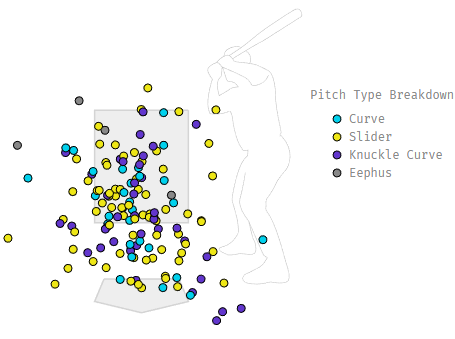The Los Angeles Dodgers‘ prospect factory is at it again.
Over the past handful of years, we have seen an abnormally large number of highly regarded Dodger prospects succeed at the major league level. At this point, it feels like it’s almost expected that the top 5 prospects in the Dodgers’ system will be, at worst, productive major-league players. Names like Joc Pederson, Corey Seager, Cody Bellinger, Walker Buehler, Alex Verdugo, Gavin Lux, Julio Urías, and beyond were all prized prospects and have made their mark on the game.
Then comes the curious case of James Outman. Prior to the 2022 season, he was the 13th-ranked prospect in the Dodgers’ system by MLB.com. Even after his (small sample size) success near the end of the 2022 season, Outman only jumped to the 8th-ranked prospect in the Dodgers’ system. He was widely regarded as an outstanding athlete, but many scouts predicted that his hit tool could hold him back.
Outman then continued to show his prowess in 2023 spring training while slashing a .283/.391/.566 stat line; as it turns out, that was enough to break camp with the Dodgers. Is he for real? Is it sustainable? Should he change his last name to something more fitting (James Rakeman comes to mind)? Let’s find out.
Minor League Overview
James Outman’s minor-league career began nearly perfectly in line with his collegiate stats at Sacramento State. He showed average bat-to-ball skills with decent pop, solid speed, and a good eye in the box. As he continued to see more professional pitching in late 2021 and 2022, though, he got more comfortable at the plate and began to trust his natural ability a bit more.
The results showed an increase in batting average (nearly 30 points!) and a sustained ~.100 point delta between his batting average and his OBP. The other remarkable trait that can only be touted by a few other prospects is that Outman seemed to get better at each level as he ascended the minor leagues. Impressively enough, that trend has continued into the majors.
What Does the Data Say?
Considering the positive results so far in his career, it’s clear that Outman does a lot of things well. Let’s dive into his statcast data via Pitcher List’s chart below and see if the expected data matches up with James’ results to this point.

Ok – before we get too deep into this, it is worth noting that Outman’s 2022 season was a TOTAL of 16 plate appearances. Most people would throw that data out as it is far too small of a sample size to be considered statistically relevant; however, his major league career to this point combines for 146 plate appearances – so we’ll use what we have! Knowing that, expect a high variance in Outman’s future performance.
As the chart above shows – Outman has some gaudy numbers across the board for both years that he’s played in the majors. However, a few things jump out to me that spark extra intrigue. Firstly, there is a fairly large gradient for BOTH years between his BA/xBA and his SLG/xSLG. Both the standard and expected values are well above average, but what does the delta between the comparable stats tell us?
Though it is typically driven by a combination of factors, this data seems to suggest that James has been a bit lucky to this point in his career. “Luck” is typically viewed in a negative light, but that isn’t always the case. Certain hitting profiles tend to find more holes or gaps when compared to others. Also, SPEED has a massive impact on output, and as we’ve noted (and his 91st percentile in arm strength and 87th percentile in sprint speed solidify), James Outman is an exceptional athlete.
In the longer term and over a significantly larger sample size, I think we can expect Outman’s batting average, weighted on-base average, and slugging percentage to approach the expected-equivalent metric values. This would, in theory, result in a ~.250/.370/.520 slash line. Interestingly enough, a player with a strikingly similar hitting profile is none other than his Dodgers’ teammate: Max Muncy. I think that the Dodgers would have no issue with having a faster, outfield version of Max Muncy as a staple in their lineup.
Plate Discipline and Approach
We’ve established that Outman has all the tools to be successful, but how has he been able to be productive? One of the more intriguing aspects of Outman’s hitting profile is the exceptionally high strikeout rate combined with an above-average walk rate. As we know, major league pitchers will find even the smallest hole in a hitter’s swing and exploit it. Typically when this happens, however, hitters tend to struggle at the plate until they make their own adjustment – be it mechanical or approach.
Outman’s results have been different. He is in the bottom 6th percentile in Called Strikes + Whiffs (CSW%); this means there is a LOT of “swing and miss” in his game. Additionally, his overall contact percentage is just in the 4th percentile of the MLB. In fact, his contact percentage on pitches thrown out of the zone (o-contact%) is 43% – roughly 20% below league average.
However, Outman’s contact percentage on pitches thrown in the zone (z-contact%) is 77.4% – just 9% lower than league average. While James can still improve upon his z-contact%, the root of his contact issues is quite simply this: he whiffs on balls thrown out of the zone too frequently.
On the flip side, Outman’s chase rate is on the opposite end of the spectrum – ranking in the 72nd percentile of MLB.
What does all of this mean, and how has he been successful in spite of putrid strikeout and contact numbers? Well, it means that Outman doesn’t swing often when the pitcher throws a ball. It’s plain and simple. James, much like the scouts from his minor league days, likely recognizes that creating consistent contact is not a strength in his batting profile. As a result, Outman swings primarily only at pitches thrown in the zone and, as evidenced by his 90% percentile barrel rate, hits the ball hard when he gets something to hit.

As shown in the Baseball Savant chart above, James Outman also struggles with breaking pitches. This is not uncommon amongst younger players who are still getting adjusted to the higher caliber major league pitching. With that being said, if Outman was to improve even marginally it could make a massive impact on his production. Currently, James is seeing breaking balls on 31% of all pitches and has a minuscule .187 xBA, .274 xwOBA, and .315 xSLG against them.
The other interesting component of how pitchers are attacking Outman can be seen by the pitch type breakdown graphic below from Baseball Savant.
In short, pitchers are just not throwing him anything to hit with breaking balls. The nucleus of pitches can be found in the low and away area of the strike zone, but beyond that, there is a significant number of pitches being intentionally thrown out of the zone. On such pitches, he is whiffing 47% of the time and only has 6 total hits – 3 singles and 3 doubles. That is not a good formula for success.
Final Thoughts
James Outman has all the tools to be a high-ceiling major-league outfielder. He crushes fastballs, has good plate discipline, and has borderline-elite speed and arm tools. If James is able to either:
1) continue his hitting approach of laying off all breaking balls/balls out of the zone
AND/OR
2) increase meaningful contact rates in the zone
…he could be a star for years to come.


My last month paycheck was for 11000 dollars…